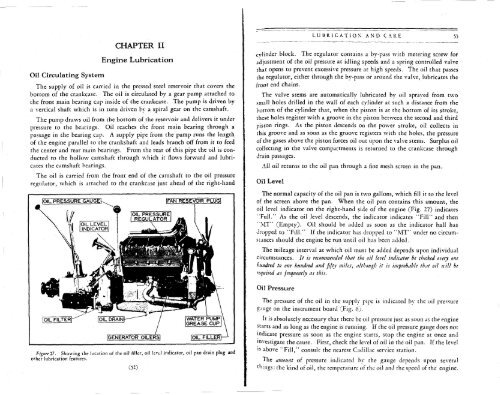1928 Cadillac - GM Heritage Center
1928 Cadillac - GM Heritage Center
1928 Cadillac - GM Heritage Center
Create successful ePaper yourself
Turn your PDF publications into a flip-book with our unique Google optimized e-Paper software.
Oil Circulating System<br />
CHAPTER II<br />
Engine Lubrication<br />
The supply of oil is carried in the pressed steel reservoir that covers the<br />
bottom of the crankcase. The oil is circulated by a gear pump attached to<br />
the front main bearing cap inside of the crankcase. The pump is driven by<br />
a vertical shaft which is in turn driven by a spiral gear on the camshaft.<br />
The pump draws oil from the bottom of the reservoir and delivers it under<br />
pressure to the bearings. Oil reaches the front main bearing through a<br />
passage in the bearing cap. A supply pipe from the pump runs the length<br />
of the engine parallel to the crankshaft and leads branch off from it to feed<br />
the center and rear main bearings. From the rear of this pipe the oil is conducted<br />
to the hollow camshaft through which it flows forward and lubricates<br />
the camshaft bearings.<br />
The oil is carried from the front end of the camshaft to the oil pressure<br />
regulator, which is attached to the crankcase just ahead of the right-hand<br />
LUBRICATION' AND CARE 53<br />
cylinder block. The regulator contains a by-pass with metering screw for<br />
adjustment of the oil pressure at idling speeds and a spring controlled valve<br />
that opens to prevent excessive pressure at high speeds. The oil that passes<br />
the regulator, either through the by-pass or around the valve, lubricates the<br />
front end chains.<br />
The valve stems are automatically lubricated by oil sprayed from two<br />
small holes drilled in the wall of each cylinder at such a distance from the<br />
bottom of the cylinder that, when the piston is at the bottom of its stroke,<br />
these holes register with a groove in the piston between the second and third<br />
piston rings. As the piston descends on the power stroke, oil collects in<br />
this groove and as soon as the groove registers with the holes, the pressure<br />
of the gases above the piston forces oil out upon the valve stems. Surplus oil<br />
collecting in the valve compartments is returned to the crankcase through<br />
drain passages.<br />
All oil returns to the oil pan through a fine mesh screen in the pan.<br />
Oil Level<br />
The normal capacity of the oil pan is two gallons, which fill it to the level<br />
of the screen above the pan. When the oil pan contains this amount, the<br />
oil level indicator on the right-hand side of the engine (Fig. 27) indicates<br />
"Full." As the oil level descends, the indicator indicates "Fill" and then<br />
"MT" (Empty). Oil should be added as soon as the indicator ball has<br />
dropped to "Fill." If the indicator has dropped to "NIT" under no circumstances<br />
should the engine be run until oil has been added.<br />
The mileage interval at which oil must be added depends upon individual<br />
circumstances. It is recommended that the oil level indicator be checked every one<br />
hundred to one hundred and fifty miles, although it is improbable that oil will be<br />
required as frequently as this.<br />
Oil Pressure<br />
Figure 27. Showing the location of the oil filler, oil level indicator, oil pan drain plug and<br />
orher lubrication features.<br />
(52)<br />
The pressure of the oil in the supply pipe is indicated by the oil pressure<br />
gauge on the instrument board (Fig. 6).<br />
It is absolutely necessary that there be oil pressure just as soon as the engine<br />
starts and as long as the engine is running. If the oil pressure gauge does not<br />
indicate pressure as soon as the engine starts, stop the engine at once and<br />
investigate the cause. First, check the level of oil in the oil pan. If the level<br />
is above "Fill," consult the nearest <strong>Cadillac</strong> service station.<br />
The amount of pressure indicated by the gauge depends upon several<br />
things: the kind of oil, the temperature of the oil and the speed of the engine.
















